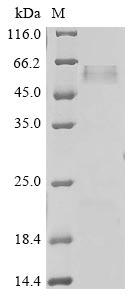Recombinant Human Dystroglycan (DAG1) , partial
CAT:
399-CSB-YP613486HU-02
Size:
100 µg
Price:
Ask
- Availability: 24/48H Stock Items & 2 to 6 Weeks non Stock Items.
- Dry Ice Shipment: No




Recombinant Human Dystroglycan (DAG1) , partial
- CAS Number: 9000-83-3
- Gene Name: DAG1
- UniProt: Q14118
- Expression Region: 30-653aa
- Organism: Homo sapiens
- Target Sequence: HWPSEPSEAVRDWENQLEASMHSVLSDLHEAVPTVVGIPDGTAVVGRSFRVTIPTDLIASSGDIIKVSAAGKEALPSWLHWDSQSHTLEGLPLDTDKGVHYISVSATRLGANGSHIPQTSSVFSIEVYPEDHSELQSVRTASPDPGEVVSSACAADEPVTVLTVILDADLTKMTPKQRIDLLHRMRSFSEVELHNMKLVPVVNNRLFDMSAFMAGPGNAKKVVENGALLSWKLGCSLNQNSVPDIHGVEAPAREGAMSAQLGYPVVGWHIANKKPPLPKRVRRQIHATPTPVTAIGPPTTAIQEPPSRIVPTPTSPAIAPPTETMAPPVRDPVPGKPTVTIRTRGAIIQTPTLGPIQPTRVSEAGTTVPGQIRPTMTIPGYVEPTAVATPPTTTTKKPRVSTPKPATPSTDSTTTTTRRPTKKPRTPRPVPRVTTKVSITRLETASPPTRIRTTTSGVPRGGEPNQRPELKNHIDRVDAWVGTYFEVKIPSDTFYDHEDTTTDKLKLTLKLREQQLVGEKSWVQFNSNSQLMYGLPDSSHVGKHEYFMHATDKGGLSAVDAFEIHVHRRPQGDRAPARFKAKFVGDPALVLNDIHKKIALVKKLAFAFGDRNCSTITLQNITRG
- Tag: N-terminal 6xHis-tagged
- Source: Yeast
- Field of Research: Neuroscience
- Assay Type: Developed Protein
- Relevance: The dystroglycan complex is involved in a number of processes including laminin and basement membrane assembly, sarcolemmal stability, cell survival, peripheral nerve myelination, nodal structure, cell migration, and epithelial polarization. Alpha-dystroglycan is an extracellular peripheral glycoprotein that acts as a receptor for both extracellular matrix proteins containing laminin-G domains. Receptor for laminin-2 (LAMA2) and agrin in peripheral nerve Schwann cells. Beta-dystroglycan is a transmembrane protein that plays important roles in connecting the extracellular matrix to the cytoskeleton. Acts as a cell adhesion receptor in both muscle and non-muscle tissues. Receptor for both DMD and UTRN and, through these interactions, scaffolds aXIn to the cytoskeleton. Also functions in cell adhesion-mediated signaling and implicated in cell polarity. (Microbial infection) Alpha-dystroglycan acts as a receptor for lassa virus and lymphocytic choriomeningitis virus glycoprotein and class C new-world arenaviruses (PubMed:16254364, PubMed:19324387, PubMed:17360738). Alpha-dystroglycan acts as a Schwann cell receptor for Mycobacterium leprae, the causative organism of leprosy, but only in the presence of the G-domain of LAMA2 (PubMed:9851927).
- Purity: Greater than 85% as determined by SDS-PAGE.
- Activity: Not Test
- Length: Partial
- Form: Liquid or Lyophilized powder
- Buffer: If the delivery form is liquid, the default storage buffer is Tris/PBS-based buffer, 5%-50% glycerol. If the delivery form is lyophilized powder, the buffer before lyophilization is Tris/PBS-based buffer, 6% Trehalose, pH 8.0.
- Reconstitution: We recommend that this vial be briefly centrifuged prior to opening to bring the contents to the bottom. Please reconstitute protein in deionized sterile water to a concentration of 0.1-1.0 mg/mL.We recommend to add 5-50% of glycerol (final concentration) and aliquot for long-term storage at -20℃/-80℃. Our default final concentration of glycerol is 50%. Customers could use it as reference.
- Molecular Weight: 69.8 kDa
- References & Citations: "Characterization of site-specific O-glycan structures within the mucin-like domain of {alpha}-dystroglycan from human skeletal muscle." Nilsson J., Nilsson J., Larson G., Grahn A. Glycobiology 20:1160-1169 (2010)
- Storage Conditions: The shelf life is related to many factors, storage state, buffer ingredients, storage temperature and the stability of the protein itself. Generally, the shelf life of liquid form is 6 months at -20℃/-80℃. The shelf life of lyophilized form is 12 months at -20℃/-80℃.
